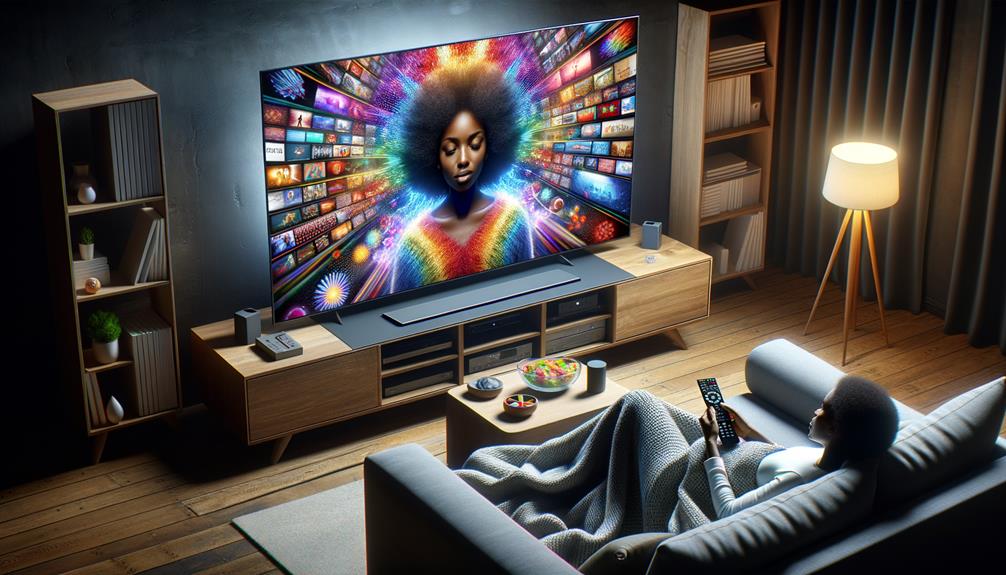
Digital TV employs modern digital transmission techniques to deliver superior picture and sound quality compared to analog systems.
It utilises binary code for more consistent and reliable signal transmission, ensuring minimal degradation and interference.
This technology supports various formats including HDTV and SDTV, and allows for efficient bandwidth use, enabling the transmission of multiple subchannels within the same bandwidth.
Enhanced video coding standards further reduce compression artifacts, preserving the quality of viewing experience.
As the technical landscape advances, understanding the latest developments in digital TV technology can greatly enhance user satisfaction and interaction with media content.
Quick Summary
- Digital TV transmits high-quality audio and video using binary code, enhancing signal reliability and viewing experience.
- It supports various formats, including HDTV and SDTV, predominantly in a 16:9 aspect ratio.
- Offers multiple subchannels within a single bandwidth, improving efficiency and service variety.
- Utilises advanced video coding standards to reduce compression artifacts and maintain image quality.
- Available via different transmission methods such as terrestrial, cable, and satellite, ensuring broad accessibility.
History of Digital TV
The evolution of digital television, fundamentally shaped by advances in high-performance computing during the 1990s, marked a significant technological shift from traditional analog systems.
This transformation began in earnest when companies like Toshiba, Sony, and NEC first introduced digital-capable TV sets in the mid-1980s.
The evolution timeline accelerated with General Instrument’s demonstration in 1990, proving the viability of a digital television signal.
The impact on the industry was profound, prompting the FCC to delay decisions on the analog-based ATV standard in favour of developing a digitally-based one.
Concurrently, European organisations concentrated efforts on optimising DCT-based digital video coding standards, underlining the global shift towards digital broadcasting systems and setting the stage for widespread adoption and regulatory changes.
Technical Specifications
Delving into the technical specifications, digital TV supports various picture formats, including high-definition (HDTV) and standard-definition (SDTV) formats such as 720p and 1080i, which utilise a 16:9 aspect ratio.
This importance in aspect ratios guarantees a consistent viewing experience across different media platforms.
Additionally, the bandwidth allocation in digital broadcasting permits the transmission of multiple subchannels within the same frequency band, maximising the efficiency of spectrum use.
Digital transmission methods, including terrestrial, cable, and satellite, offer robust pathways for signal delivery.
Importantly, protection parameters are implemented to safeguard signal integrity, minimising the risk of degradation or unauthorised interception.
Although compression artifacts pose challenges, ongoing enhancements in video coding standards are pivotal in mitigating these issues, thereby preserving the quality of the digital viewing experience.
Analog Vs Digital Comparison

While both analog and digital TV technologies serve the same basic purpose of broadcasting television content, digital TV distinguishes itself by offering markedly higher picture and sound quality.
Digital TV transmits content using binary code, enhancing signal quality and ensuring greater transmission reliability.
Unlike analog TV, which relies on radio frequency waves prone to interference and signal degradation, digital signals maintain integrity, minimising disruptions caused by external factors.
This change not only boosts the efficiency of bandwidth usage, permitting the inclusion of additional channels and services but also greatly improves the reliability of the broadcast.
The global shift towards digital broadcasting underscores these advantages, aiming to provide viewers with an uninterrupted, superior television experience.
Current Market Deals
Exploring current market deals reveals a variety of competitive packages designed to cater to diverse consumer needs and preferences in digital TV services.
Analysing these offerings provides insights into prevailing market trends and strategic pricing strategies. Here’s a concise overview:
| Package Name | Monthly Cost | Features & Inclusions |
|---|---|---|
| Full Works + Fibre 2 | £107.99 | Big Sport, Full Fibre 75, Sky Stream, Netflix |
| Sky Stream + Full Fibre 75 | £37.00 | No dish required, £10 upfront cost |
| Bigger Combo Bundle | £39.99 | M350 Broadband, Maxit TV Pack, Weekend Chatter, WiFi |
| Cash-Pagne Supernova! | Entry | Chance to win £1000, partnership with Sky |
For tailored advice and the best package selection, consumers are encouraged to consult the expert team.
Buying a Digital TV Box

When purchasing a digital TV box, it’s important to evaluate the range of options available, including Freeview, Freesat, and various smart TV boxes that provide access to streaming platforms.
Assess the ease of setup, channel availability, and unique features of each type.
Smart TV boxes, for example, facilitate access to services like Netflix and BBC iPlayer.
To optimise installation, use tools like the Freeview Channel Checker, which assists in troubleshooting reception problems.
Looking forward, anticipate innovations in digital TV technology that might enhance user interaction and streaming quality.
These advancements could influence future buying decisions, making it essential to take into account both current capabilities and potential technological evolutions when selecting a digital TV box.
Choosing the Right Package
Selecting the appropriate digital TV package requires careful consideration of both your entertainment needs and the services available in your area.
Begin with a thorough package comparison, focusing on whether a TV-only or a TV and broadband bundle best suits your usage patterns.
Cost analysis is essential; evaluate set-up expenses and monthly fees against your budget constraints.
Channel selection must be prioritised based on your preferences, whether it’s sports, news, or entertainment genres.
Additionally, assess the significance of streaming integration within these packages, especially if your consumption leans heavily towards online platforms.
This analysis guarantees that the chosen digital TV package aligns effectively with both your financial limits and entertainment requirements, enhancing overall satisfaction with the service.
Provider Comparisons

Comparing providers such as BT, Sky, NOW, TalkTalk, and Virgin Media reveals significant differences in channel offerings, additional features, and subscription models.
Each provider tailors its services to cater to diverse customer needs, focusing on aspects like channel availability and bundle options.
A vital analysis of these factors is essential for a thorough evaluation.
- BT: Known for exclusive channels like BT Sport and AMC, alongside premium channel add-ons.
- Sky: Offers extensive channel line-up including Sky Atlantic, Cinema, and Sports.
- NOW: Provides flexible access to premium Sky channels through themed memberships.
- TalkTalk: Features a basic set of over 70 Freeview channels with options for fast broadband.
- Virgin Media: Broad range with over 210 channels, but lacks Sky Atlantic.
These options vary greatly in pricing comparison and customer service quality, impacting consumer choice.
Expert Tips and Guides
To optimise your digital TV experience, consider expert tips that address set-up costs, streaming preferences, and channel selection methodologies.
When selecting a provider, evaluate the streaming quality offered. High-definition or ultra-high-definition options greatly enhance viewing pleasure but vary extensively between services like Freeview, Freesat, Sky, and broadband-based TV.
Assess your typical data usage, especially if your household streams regularly or in high quality. Providers often have data caps or offer unlimited data for a premium.
Understanding these factors will prevent unexpected costs and guarantee a seamless streaming experience.
Additionally, consider bundled deals that might include faster broadband speeds essential for high-quality streaming, particularly if multiple users are connected simultaneously.
Frequently Asked Questions
What Is a Digital TV?
A digital television is a device that utilises signal conversion technology to comply with broadcasting standards, enabling the reception and display of digital signals for enhanced audio and visual media consumption.
Do You Need an Aerial for Digital TV?
To guarantee excellent signal quality for television reception, an aerial is necessary. It supports various installation options, greatly enhancing the ability to capture and decode broadcast signals effectively.
Is Freeview the Same as Digital TV?
Freeview, a specific broadcasting technology, offers access to various channels but represents just one aspect of broader digital television services, which include multiple platforms like satellite and cable, each with unique channel availabilities.
What Is the Difference Between a Smart TV and a Digital TV?
Smart TVs integrate internet, offering streaming compatibility and advanced remote functionalities, enhancing user interaction and content access. Conversely, digital TVs primarily focus on broadcasting digital signals with standard remote capabilities and limited internet integration.
Conclusion
In summary, the shift to digital television represents a significant technological advancement, offering enhanced picture and sound quality, increased channel capacity, and interactive features over its analog counterpart.
Consumers are encouraged to carefully evaluate the technical specifications and provider options to maximise the benefits of digital TV.
Thorough comparison and understanding of available packages guarantee an informed decision, leveraging expert insights for the best selection and utilisation of digital television technology in contemporary media consumption landscapes.
